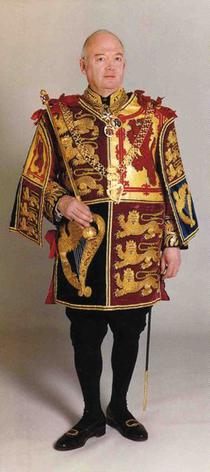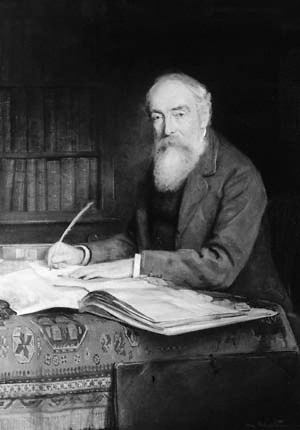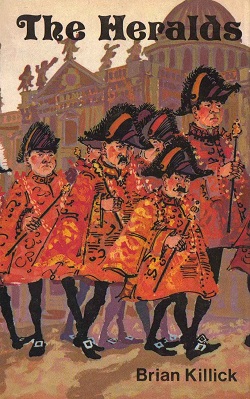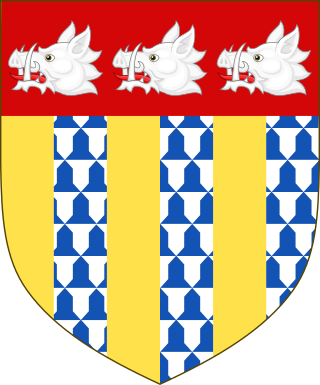Related Research Articles

Sir William Dugdale was an English antiquary and herald. As a scholar he was influential in the development of medieval history as an academic subject.

The Right Honourable the Lord Lyon King of Arms, the head of Lyon Court, is the most junior of the Great Officers of State in Scotland and is the Scottish official with responsibility for regulating heraldry in that country, issuing new grants of arms, and serving as the judge of the Court of the Lord Lyon, the oldest heraldic court in the world that is still in daily operation.

Edmund Lodge, KH (1756–1839), herald, was a long-serving English officer of arms, a writer on heraldic subjects, and a compiler of short biographies.

John Philip Brooke Brooke-Little was an English writer on heraldic subjects, and a long-serving herald at the College of Arms in London. In 1947, while still a student, Brooke-Little founded the Society of Heraldic Antiquaries, now known as the Heraldry Society and recognised as one of the leading learned societies in its field. He served as the society's chairman for 50 years and then as its president from 1997 until his death in 2006.

George Edward Cokayne,, was an English genealogist and long-serving herald at the College of Arms in London, who eventually rose to the rank of Clarenceux King of Arms. He wrote such authoritative and standard reference works as The Complete Peerage and The Complete Baronetage.

Sir Arthur William Steuart Cochrane was a long-serving Officer of Arms at the College of Arms in London.
Sir John Dunamace Heaton-Armstrong was a long-serving English officer of arms at the College of Arms in London.

Heraldic visitations were tours of inspection undertaken by Kings of Arms throughout England, Wales and Ireland. Their purpose was to register and regulate the coats of arms of nobility, gentry and boroughs, and to record pedigrees. They took place from 1530 to 1688, and their records provide important source material for historians and genealogists.
Sir Richard St George was a long-serving officer of arms at the College of Arms in London during the seventeenth century.

The Heralds is a novel written by Brian Killick in 1973. It is a fictional account of the inner workings of the College of Arms in London. The book follows the exploits of the college's members after the announcement that the current Garter Principal King of Arms will be retiring.

Sir William Segar was a portrait painter and officer of arms to the court of Elizabeth I of England; he became Garter King of Arms under James I.
William Flower (1497/98–1588) was an English Officer of Arms in the reigns of Henry VIII, Edward VI, Mary I and Elizabeth I. He rose to the rank of Norroy King of Arms, serving in that capacity from 1562 until his death in 1588.

Robert Glover was an English officer of arms, genealogist and antiquarian in the reign of Elizabeth I. In the College of Arms, he rose to the rank of Somerset Herald of Arms, serving in that capacity from 1571 until his death in 1588. As marshal and deputy to his father-in-law, William Flower, Norroy King of Arms, he participated in heraldic visitations throughout northern England.

Robert Cooke was an English Officer of Arms during the reign of Elizabeth I, who rose swiftly through the ranks of the College of Arms to Clarenceux King of Arms, serving in that office from 1567 until his death in 1592–3.
Sir Edward Bysshe FRS (1615?–1679) was an English barrister, politician and officer of arms. He sat in the House of Commons variously between 1640 and 1679 and was Garter King of Arms during the Commonwealth period.

John Clench was an English judge, a Serjeant-at-Law, Baron of the Exchequer and Justice of the Queen's Bench, of the late Tudor period. He established his family in south-east Suffolk, in the neighbourhood of Ipswich, where for many years he was the Town Recorder.
Henry St George, the younger, was an English officer of arms. He was a younger son of the herald Henry St George (1581–1644).
Sir Herbert Whitfield (1617–1677) was an English lawyer and landowner, whose pedigree and arms were recorded in both the 1619 Visitation of Kent and the 1623 Visitation of Surrey.

James Pulman was an English officer of arms.
William Ryley was an officer of arms at the College of Arms in London.
References
- ↑ W. Dugdale, Origines Juridiciales, Third (enlarged) edition (Christopher Wilkinson, Thomas Dring and Charles Harper, London 1680), p. 195 (Google).
- ↑ Origines Juridiciales, 3rd edn, p. 148 (Google).
- ↑ Origines Juridiciales, 3rd edn, p. 209 (Google).
- ↑ 'Council held on November 24th 1600', in The Black Books of Lincoln's Inn, II: 1586-1660 (Lincoln's Inn 1898), p. 66 (Internet Archive).
- ↑ 'Council held on October 15th 1601', in The Black Books of Lincoln's Inn, II: 1586-1660, p. 69 (Internet Archive).
- ↑ 'Council held on May 1st 1621' and 'Council held on February 6th 1622', in The Black Books of Lincoln's Inn, II: 1586-1660, p. 221 and p. 229 (Internet Archive).
- ↑ R.J. Fletcher (ed.), The Pension Book of Gray's Inn (Records of the Honourable Society) I: 1559-1659 (Masters of the Bench/Stevens & Haynes, London 1901), pp. xxxii-xxxv (Internet Archive).
- ↑ 'Earl Marshal's Orders, 1568', in G.D. Squibb (ed.), Munimenta Heraldica, 1484-1984, Harleian Society, New Series IV (1985). Text reproduced at Elizabethan Heraldry website (elizabethan.org).
- ↑ See also '235. Orders to be obseruide (etc.)', in Minutes of Evidence Taken Before the Committee for Privileges to Whom the Petition of Sir Henry Paston Bedingfield of Oxburgh... were referred (By Order, 1854), pp. 350-55 (Google).
- ↑ 'Confirmation by William Camden', etc., in A Catalogue of the Antiquities and Works of Art Exhibited at Ironmongers Hall, London, in the month of May, 1861, London and Middlesex Archaeological Society (Harrison and Sons, London 1869), p. 277 (Google).
- ↑ T. Carte, An History of the Life of James Duke of Ormonde from His Birth, 2 vols (J.J. and P. Knapton, London 1736), I (Introduction), pp. xlvj-xlvij (Google).
- ↑ 'Letters Patent for the Limitation of the Crown', in J.G. Nichols (ed.), The Chronicle of Queen Jane, and of Two Years of Queen Mary, Camden Society XLVIII (1850), p. 91-100 (Google).